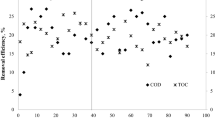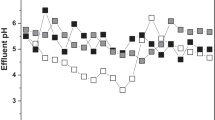Abstract
Some bacteria common in anaerobic digestion process can ferment a broad variety of organic compounds to organic acids, alcohols, and hydrogen, which can be used as biofuels. Researches are necessary to control the microbial interactions in favor of the alcohol production, as intermediary products of the anaerobic digestion of organic compounds. This paper reports on the effect of buffering capacity on the production of organic acids and alcohols from wastewater by a natural mixed bacterial culture. The hypothesis tested was that the increase of the buffering capacity by supplementation of sodium bicarbonate in the influent results in benefits for alcohol production by anaerobic fermentation of wastewater. When the influent was not supplemented with sodium bicarbonate, the chemical oxygen demand (COD)-ethanol and COD-methanol detected in the effluent corresponded to 22.5 and 12.7 % of the COD-sucrose consumed. Otherwise, when the reactor was fed with influent containing 0.5 g/L of sodium bicarbonate, the COD-ethanol and COD-methanol were effluents that corresponded to 39.2 and 29.6 % of the COD-sucrose consumed. Therefore, the alcohol production by supplementation of the influent with sodium bicarbonate was 33.6 % higher than the fermentation of the influent without sodium bicarbonate.


Similar content being viewed by others
References
Lee, S. Y., Park, J. H., Jang, S. H., Nielsen, L. K., Kim, J., & Jung, K. S. (2008). Biotechnology Bioengineering, 101(2), 209–228.
Grobben, N., Eggink, G., Cuperus, F. P., & Huizing, H. J. (1993). Applied Microbiology and Biotechnology, 39, 494–498.
Fujita, H., Qian, Q., Fujii, T., Mochizuchi, K., & Sakoda, A. (2011). Adsorption, 17, 869–879.
Kujawski, W., & Roszak, R. (2001). Separation Science and Technology, 37(15), 3559–3575.
Mariano, A. P., & Maciel Filho, R. (2012). Bioenergy Research, 5, 504–514.
He, G., Kong, Q., Chen, Q., & Ruan, H. (2005). Journal of Zhejiang University. Science, 6B(11), 1076–1080.
Hartmanis, M. G. N., & Gatenbeck, S. (1984). Applied and Environmental Microbiology, 47(6), 1277–1283.
Ezeji, T., Milne, C., Price, N. D., & Blaschek, H. P. (2010). Applied Microbiology and Biotechnology, 85, 1697–1712.
Leite, J. A. C., Fernandes, B. S., Pozzi, E., Barboza, M., & Zaiat, M. (2008). International Journal of Hydrogen Energy, 33, 579–586.
Penteado, E.D., Adorno, M.A.T., & Zaiat, M. (2012). In Annals of the 38th International Symposium on High Performance Liquid Phase Separations and Related Techniques, California, USA.
APHA (1998) Standard method for the examination of water and wastewater. 20th ed. Washington D.C., USA.
Griffiths, R. I., Whiteley, A. S., O’donnell, A. G., & Bailey, M. J. (2000). Applied and Environmental Microbiology, 66(12), 5488–5491.
Nielsen, A. T., Liu, W., Filipe, C., Grady, L., Jr., Molin, S., & Stahl, D. (1999). Applied Environmental Microbiology, 65(3), 1251–1258.
Muyzer, G., Waal, E. C., & Uitterlinden, G. (1993). Applied and Environmental Microbiology, 56, 695–700.
D’Agostino, R. B., Belanger, A., & D’Agostino, R. B., Jr. (1990). American Statistician, 44(4), 316–321.
Lilliefors, H. W. (1967). Journal American Statistical Association, 62(318), 399–402.
Mood, A. M. (1954). Annals of Mathematical Statistics, 25(3), 514–522.
Acknowledgments
The authors are grateful for the financial support (Thematic Project, Proc. no. 2009/15984-0) and fellowship (granted to Ariovaldo José da Silva Process. n. 2010/20024-3) provided by the São Paulo Research Foundation—FAPESP. The authors thank Espaço da Escrita—Coordenadoria Geral da Universidade—UNICAMP—for the language services provided.
Author information
Authors and Affiliations
Corresponding author
Rights and permissions
About this article
Cite this article
Silva, A.J., Pozzi, E., Foresti, E. et al. The Influence of the Buffering Capacity on the Production of Organic Acids and Alcohols from Wastewater in Anaerobic Reactor. Appl Biochem Biotechnol 175, 2258–2265 (2015). https://doi.org/10.1007/s12010-014-1424-y
Received:
Accepted:
Published:
Issue Date:
DOI: https://doi.org/10.1007/s12010-014-1424-y




